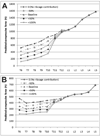A biomechanical model for estimating loads on thoracic and lumbar vertebrae
- PMID: 20655634
- PMCID: PMC2949493
- DOI: 10.1016/j.clinbiomech.2010.06.010
A biomechanical model for estimating loads on thoracic and lumbar vertebrae
Abstract
Background: Biomechanical models are commonly used to estimate loads on the spine. Current models have focused on understanding the etiology of low back pain and have not included thoracic vertebral levels. Using experimental data on the stiffness of the thoracic spine, ribcage, and sternum, we developed a new quasi-static stiffness-based biomechanical model to calculate loads on the thoracic and lumbar spine during bending or lifting tasks.
Methods: To assess the sensitivity of the model to our key assumptions, we determined the effect of varying ribcage and sternal stiffness, maximum muscle stress, and objective function on predicted spinal loads. We compared estimates of spinal loading obtained with our model to previously reported in vivo intradiscal pressures and muscle activation patterns.
Findings: Inclusion of the ribs and sternum caused an average decrease in vertebral compressive force of 33% for forward flexion and 18% in a lateral moment task. The impact of maximum muscle stress on vertebral force was limited to a narrow range of values. Compressive forces predicted by our model were strongly correlated to in vivo intradiscal pressure measurements in the thoracic (r=0.95) and lumbar (r=1) spine. Predicted trunk muscle activity was also strongly correlated (r=0.95) with previously published EMG data from the lumbar spine.
Interpretation: The consistency and accuracy of the model predictions appear to be sufficient to justify the use of this model for investigating the relationships between applied loads and injury to the thoracic spine during quasi-static loading activities.
Copyright © 2010 Elsevier Ltd. All rights reserved.
Figures




References
-
- Andersen JH, Haahr JP, Frost P. Risk factors for more severe regional musculoskeletal symptoms: a two-year prospective study of a general working population. Arthritis Rheum. 2007;56:1355–1364. - PubMed
-
- Andriacchi T, Schultz A, Belytschko T, Galante J. A model for studies of mechanical interactions between the human spine and rib cage. J Biomech. 1974;7:497–507. - PubMed
-
- Bean JC, Chaffin DB, Schultz AB. Biomechanical model calculation of muscle contraction forces: a double linear programming method. J Biomech. 1988;21:59–66. - PubMed
-
- Berg EE. The sternal-rib complex. A possible fourth column in thoracic spine fractures. Spine (Phila Pa 1976) 1993;18:1916–1919. - PubMed
-
- Brown SH, Potvin JR. Constraining spine stability levels in an optimization model leads to the prediction of trunk muscle cocontraction and improved spine compression force estimates. J Biomech. 2005;38:745–754. - PubMed
Publication types
MeSH terms
Grants and funding
LinkOut - more resources
Full Text Sources

